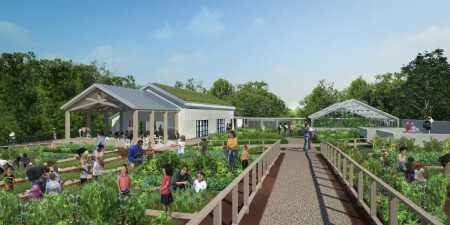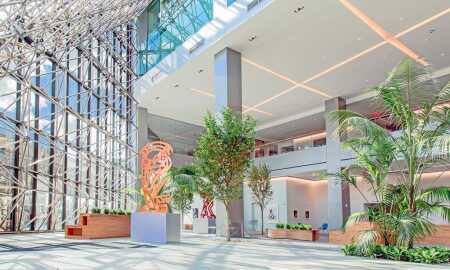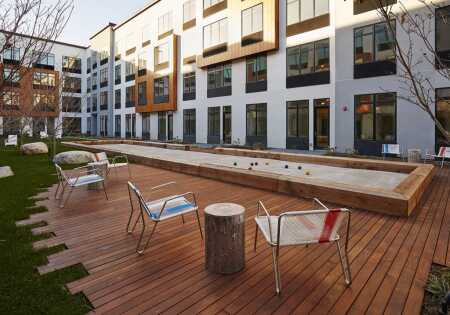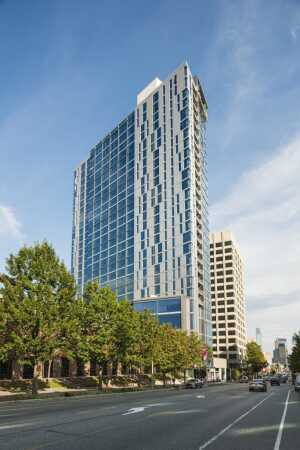New York City’s private sector job count is at an all-time high. In Philadelphia, payrolls are up, unemployment is down, and inflation is modest. And Boston’s economy is on the upswing thanks to strong growth in the education and medical sectors.
Mirroring the U.S. economy, which added 2.65 million jobs last year, according to the U.S. Department of Labor, the Northeast—New York, Massachusetts, Pennsylvania, New Jersey, and Connecticut—is reporting stronger fundamentals, spurring robust real estate development. Even though building activity has increased, real estate entrepreneurs are keeping a wary eye on fluctuations in the global economy, particularly the gyrations occurring in the energy industry and the economic uncertainty in Asia.
New York City, with its dense urban fabric, entrepreneurial spirit, and transit system enabling residents to live and play a few subway stops from where they work, is leading the way, reaching an employment peak of 4.24 million in 2015. “With the number of jobs at an all-time high, and a diverse and innovative talent pool, New York City’s economic development outlook is extremely bright,” says Maria Torres-Springer, president of the New York City Economic Development Corporation (NYCEDC). That growth is resulting in increased real estate development, she adds.
Impressive job creation, particularly in the “eds and meds” (education and medical) segments in Philadelphia, as well as in the leisure/hospitality industries, is driving new real estate projects, too. “This growth has fueled a significant amount of new office and multifamily development in the city,” says Stuart A. Margulies, senior managing principal at Lubert-Adler Partners, a locally based real estate private equity fund manager. “Today, for example, there are some 5,000 multifamily units under construction or on the drawing board in Philadelphia.”
Massachusetts’s capital also is experiencing continued economic strength in several industries including higher education, health care, and life sciences, notes Al Spagnolo, president and founding partner of local architecture, interior design, planning, and environmental graphics firm SGA. “One of the standout bright spots is the incredibly strong transportation-oriented development [TOD] and construction activity at North Station, Back Bay, and the Seaport areas in Boston; Kendall Square and Alewife in Cambridge; and Assembly Row in Somerville,” Spagnolo says. “We’re also seeing a resurgence of the higher-education sector that is expected to contribute to greater construction volume in the metropolitan area.”
With rising employment and increased real estate development, New Jersey and Connecticut also are registering heartier economic performance. Public/private partnerships in New Jersey cities including Camden, New Brunswick, and Atlantic City have been successful in attracting and leveraging new investments and creating jobs, says Anthony J. Perno III, chief executive officer of Camden-based Cooper’s Ferry Partnership, a nonprofit real estate development corporation. “Mayor Dana Redd, together with county, state, and federal partners and institutions, is leading a culture of collaboration that is creating a foundation for community and economic development and attracting new private corporations like Subaru, Holtec International, Lockheed Martin, the Philadelphia 76ers, and others,” he adds. “Camden has over $1 billion in new private investments.”
While still feeling the effects of the 2008 economic downturn, Connecticut is experiencing a recovery, says Fred V. Carstensen, professor of finance and economics and director of the Connecticut Center for Economic Analysis at the University of Connecticut’s School of Business in Storrs. “Despite steady job growth, though, Connecticut’s total employment is still below the previous peak in early 2008, and its total output, in real terms, remains below the previous peak,” he points out.
New York
Dynamic finance, insurance, and real estate (FIRE) sectors as well as strong technology, advertisement, media, and information (TAMI) industries are propelling increased real estate activity in New York City, says Alan G. Rubenstein, senior vice president/regional office sector head at New York–based Clarion Partners, a real estate investment manager.
“The New York real estate industry is performing optimally right now, with sustained job growth across many disciplines,” he says. “Notwithstanding nervousness about the age of the current economic recovery, rising interest rates, global threats like the Chinese economic slowdown, and disruptions in the Middle East and elsewhere, the New York economy continues to grow in a balanced and positive direction. Our research projects ongoing tightening of availability, even as new construction deliveries take place in Hudson Yards and the World Trade Center over the next two years.”
The financial services sector—the historical engine of New York City’s economy—has regained all the jobs lost in the 2008 meltdown, Rubenstein adds. “In addition, the economy has diversified with the growth of the TAMI sector, which has added a significant number of jobs and driven the vacancy rate in midtown south to one of the lowest in the country,” he says. “As space availability in midtown south has dwindled and rents have risen, tech, advertisement, media, and information tenants are migrating further north and south and driving positive absorption in midtown and downtown.”
Clarion is involved in a number of projects in the area including two commercial developments, 390 Madison and 180 Maiden Lane: “390 Madison at Madison Avenue and 46th Street will offer 900,000 square feet [84,000 sq m] of office space on 32 floors, including a one-of-a-kind triple-height space. It is expected to be completed in 2017.”
The city’s strong real estate fundamentals are attracting increased interest from investors. Significant capital continues to flow into the New York City market, with no slowdown forecast at this point, says Jonathan Pfeil, vice president for acquisitions at Boston-based Berkshire Group, a real estate investment management company. “With strong job growth and low interest rates, New York continues to be a market in which investors desire to be,” he adds.
Multifamily market fundamentals in New York City also are expanding, further increasing investor interest, says Gleb Nechayev, senior vice president for economic and market research at
Berkshire Group. Fueled by employment growth and a rising share of households who rent, multifamily demand remains strong. Multifamily investment sales in 2015 approached $20 billion citywide, with cap rates on higher-quality multifamily assets in the 3.5 percent to 4 percent range, he explains.

To address a growing interest in urban edible gardening, Cooper Robertson was commissioned to design an expansion of the New York Botanical Garden’s Ruth Rea Howell Family Garden. Called the Edible Academy, the new facility—expected to be completed in 2018—will include a terraced lawn amphitheater and two outdoor pavilions, among other amenities. (Cooper Robertson)
“New supply has also picked up rapidly in recent years, with the current pace of multifamily construction near historical highs,” Nechayev says. “We have a positive outlook for the economy and multifamily markets in New York—and Boston—but expect to see a slightly slower pace of property income growth in 2016 as the expansion matures.”
That New York’s multifamily housing development sector is strong is important, since the city always needs more housing, says Bill Kenworthey, a partner at Cooper Robertson, a New York City–based architecture and urban design firm. “In New York, we are seeing more design opportunities for multifamily housing, especially for innovative new models for affordable housing,” he adds.
In addition to multifamily developments, Cooper Robertson is working on a number of other projects. The firm designed the new downtown Whitney Museum of Art in collaboration with Renzo Piano Building Workshop. The facility opened in 2015. “We have begun work on another major museum project, in collaboration with Adjaye Associates—the Studio Museum in Harlem,”
Kenworthey says. “We are also completing the design for the Edible Academy at the New York Botanical Garden, a year-round facility that will teach children and families about the fundamental relationships [among] plants, gardening, sustainability, nutrition, and health.”
Massachusetts
Boston’s real estate market continues to trend upward thanks to healthy economic fundamentals, says Brian Collins, senior vice president with Clarion Partners’ Asset Management Group. “Boston continues to be a highly targeted market for institutions globally,” he says. “While major FIRE tenants have rightsized, TAMI tenants continue to grow and demand more space.”
Clarion has a 3 million-square-foot (279,000 sq m) office portfolio in the area that includes properties in downtown, the Seaport, Back Bay, Cambridge, and Waltham. “The Boston Seaport Innovation District, once known as a surface parking lot desert, continues to surge with new development of Class A office towers, condominiums, rental housing, retail, and restaurants,” Collins says. “The Fort Point neighborhood has 3.8 million square feet [353,000 sq m] of classic, turn-of-the-century brick-and-beam office product and continues to push through peak pricing in both rents and value per square foot.”
High tech and higher education are two of the linchpins of demand for new real estate building in Boston, adds SGA’s Spagnolo. The firm is planning a number of properties in the area, including 50+60 Binney Street at Alexandria Center Kendall Square in Cambridge, a $220 million life-sciences complex, and the Linx development in Watertown, a conversion and expansion of a former warehouse facility into a state-of-the-art technology-focused workplace.
Collins notes that on the interiors side, the firm is designing the U.S. headquarters for software firm AutoDesk in Boston; software provider LogMeIn’s headquarters in the Seaport District; the headquarters for Infinidat, an enterprise data storage firm, in Waltham; and, typography firm Monotype’s facilities in Woburn, Massachusetts, and New York City.
Pennsylvania
Employment is expected to increase this year in the Philadelphia area as well, stimulated by medical and educational expansions. “Most of those new workers are renters, which should support the continued increase in the multifamily housing stock in Philadelphia,” says Margulies of Lubert-Adler. “Thanks to the more aggressive pricing in other core U.S. cities, institutional investors have been focusing on markets like Philadelphia. This trend should continue this year.”
With partner PMC Property Group, Lubert-Adler is developing $500 million worth of new projects in Center City: 2400 Market, which consists of 850,000 square feet (79,000 sq m) of live, work, and play space near 30th Street Station; the redevelopment of the 24-story, 607,000-square-foot (56,000 sq m) One Franklin Plaza into 400 Class A apartments and 200,000 square feet (19,000 sq m) of office space; and a multifamily site along the Schuylkill River where up to 650 new Class A residential units are planned in two phases.
Student housing and new academic buildings are among the sectors generating increased real estate activity in Pennsylvania’s largest city, says D. Kirk Harman, president of the locally based Harman Group, a structural engineering and design firm. “We expect design and construction activity in the area will pick up 10 percent to 15 percent this year,” he says. “Office space in the newer, more technologically up-to-date-buildings, and build-to-suit corporate headquarters remains strong. More older office buildings are likely to be replaced with modern mixed-use developments.”
The firm is providing structural engineering services for the Southern Land Company’s 1911 Walnut Street development, a planned 50-story, 695,000-square-foot (65,000 sq m) luxury apartment and condo tower on Philadelphia’s prestigious Rittenhouse Square as well as structural engineering and parking consulting services for Girard Square’s East Market, a 15-story, 494,000-square-foot (46,000 sq m) mixed-use development. Harman is also involved in Rodin Square, a 520,000-square-foot (48,000 sq m) mixed-use project in Philadelphia that is a development of International Financial Company and Dalian Development.
While construction is expected to remain brisk, some clouds are on the horizon. “Construction is an early reactor to increased interest rates, and small increases in the cost of money can have a serious impact on the industry,” Harman says. “The economic recovery has been slow, but we remain optimistic about the next few years.”
New Jersey
Like its northeastern neighbors, the Garden State is experiencing a surge in multifamily and mixed-use development—a response to New York City’s high-priced housing market. “Land prices in Manhattan and Brooklyn are so high, multifamily developers cannot make the numbers work,” says David J. Minno, principal of Minno Wasko Architects and Planners of Lambertville, New Jersey. “Mega–rate rental jumps at existing multifamily products have forced people to leave New York City and find more affordable housing in New Jersey,” he says. “Because it is becoming a bigger bedroom community for NYC, retail, restaurants, and service businesses in the state are benefiting.”
Minno Wasko Architects and Planners is designing 18 Park in Jersey City, a smart growth, mixed-use, transit-oriented community at a light-rail stop, as well as Harrison Commons in Harrison. “Harrison Commons is an example of how Port Authority Trans-Hudson [PATH] trains have connected an older, deteriorating industrial town to Manhattan,” Minno says. “We are working on several other projects in Harrison including Vermella at Harrison, a multifamily development, as well as a major rehab of three older industrial buildings.”
In south New Jersey, philanthropies including the William Penn Foundation and the Kresge Foundation are helping transform neighborhoods in cities such as Camden. “Mayor Redd’s administration is attracting new investments from national foundations focusing on community engagement, neighborhood plans, and creative place making—unique ways where cities are bringing together communities in underutilized public spaces,” Perno says. “These philanthropic dollars have become an integral link in the partnership model.”

New York–based real estate investment manager Clarion Partners and MHP Real Estate Services are renovating the 41-story, 1.2 million-square-foot (111,500 sq m) 180 Maiden Lane in downtown Manhattan. The vertical waterfront campus, near the East River Esplanade as well as the newly minted Seaport District, is expected to be completed in April. (Neoscape)
Connecticut
While not reporting as robust a recovery as other northeastern states, Connecticut is seeing an upswing in its real estate market, with investor interest increasing. “National and international investors are looking for transactions, and with all the data available, good deals still exist,” says Kent Hanley, executive vice president/general manager at William Raveis Real Estate, Mortgage & Insurance in Greenwich. “With interest rates still at historic lows, there are some good opportunities.”
Even though demand for new residential construction in Connecticut has increased, development remains spotty, he adds. “We just are not seeing as many builders in the market as we have seen in the past,” he says.
Housing prices in Connecticut are strengthening, with a significant increase in permitting for multifamily developments, says Carstensen of the Connecticut Center for Economic Analysis.
“Residential in Fairfield County is doing the best in the state, in part because of employment opportunities for residents in the New York metro area,” he adds.
Thanks to strong job growth throughout the area and improving economies, real estate development in New York, Massachusetts, Pennsylvania, New Jersey, and Connecticut continues its upturn. Barring unexpected adverse effects from the global economy, the U.S. Northeast is poised to report additional real estate activity in the future.
Mike Sheridan is a freelance writer in Parsippany, New Jersey.











![Western Plaza Improvements [1].jpg](https://cdn-ul.uli.org/dims4/default/15205ec/2147483647/strip/true/crop/1919x1078+0+0/resize/500x281!/quality/90/?url=https%3A%2F%2Fk2-prod-uli.s3.us-east-1.amazonaws.com%2Fbrightspot%2Fb4%2Ffa%2F5da7da1e442091ea01b5d8724354%2Fwestern-plaza-improvements-1.jpg)

